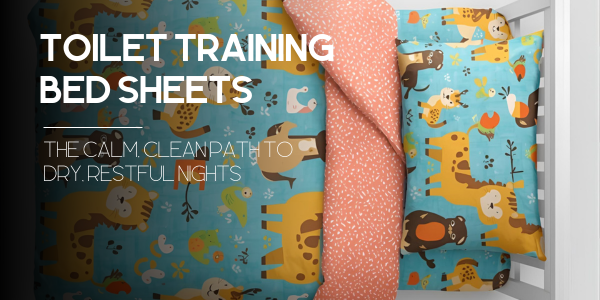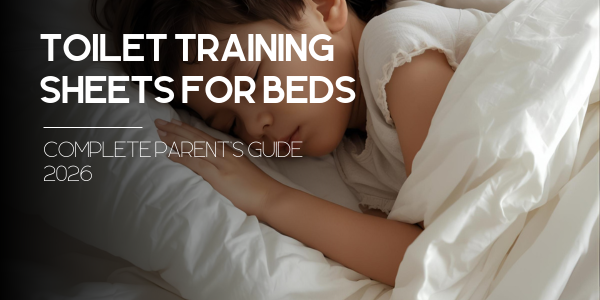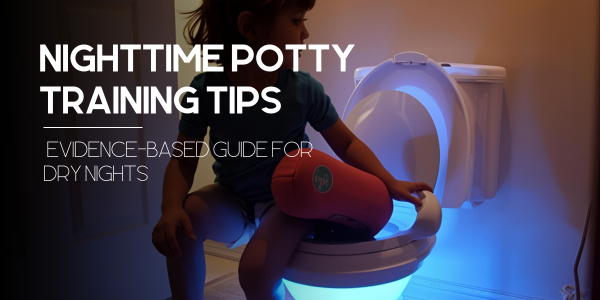Nighttime Potty Training: A Shame-Free, Science-Backed Guide to Dry Nights
Nighttime Potty Training: A Shame-Free, Science-Backed Guide to Dry Nights
Real talk. Real science. Real-life gear that keeps sleep sacred.
Normalize It If your kid is still wet at night—you’re not alone. About 20% of 5-year-olds and up to 10% of 7-year-olds still have nighttime accidents; even in the late teens, it’s around 1–3%. That’s biology, not bad parenting. :contentReference[oaicite:0]{index=0}
And there’s good news: bedwetting often improves on its own at roughly 14–15% per year. We’ll help you accelerate progress with an evidence-based, dignity-first plan—and stress-saving protection for the mattress while you train. :contentReference[oaicite:1]{index=1}
Let’s Ditch the Shame (and Keep the Sheets Dry)
We lead with compassion because punishment backfires. Major guidelines emphasize that bedwetting is not a child’s fault; support, not shame, drives progress. :contentReference[oaicite:2]{index=2}
Start with a mindset reset—and a plan. For a warm, optimistic primer, bookmark our positive, forward-thinking guide to bedwetting.
Night Dryness ≠ Daytime Training: What the Body Needs
Bladder capacity, sleep arousability & hormones
Night dryness depends on three maturing systems: a bladder that can hold overnight, a brain that wakes to full-bladder signals, and circadian release of antidiuretic hormone (ADH) to slow urine at night. Many kids don’t hit this trio until ages 5–7+—totally normal. :contentReference[oaicite:3]{index=3}
Curious how our materials manage leaks as biology catches up? Explore the science behind our leak-lock fabrics.
Green-Light Cues
- Multiple dry mornings per week
- Daytime dryness is stable; child can “hold” and make it to the toilet
- They can wake (with a nudge) to pee at night
Yellow-Light Cues
- Frequent constipation, loud snoring, or daytime urgency—address these first (see below). :contentReference[oaicite:7]{index=7}
- New wetting after 6+ months dry—check in with your pediatrician. :contentReference[oaicite:8]{index=8}
Not sure where your 7- or 8-year-old fits? These quick reads help: 7-year-old still wetting—expert tips and why 8-year-old bedwetting is developmental.
Why Bedwetting Happens (and What You Can Actually Do)
Constipation (the stealth culprit)
Backed by population studies, constipation is frequently linked to lower urinary tract symptoms and can sink enuresis treatment if ignored. Treating constipation improves outcomes for many kids. :contentReference[oaicite:9]{index=9}
Starter toolkit: fiber, fluids, stool diary, and clinician-guided plans.
Sleep & Breathing (snoring, OSA)
Children with obstructive sleep apnea show higher rates of bedwetting; addressing airway issues often improves nights. If your child snores loudly or seems unrested, ask your clinician about a sleep evaluation. :contentReference[oaicite:10]{index=10}
ADHD & Neurodiversity
There’s a documented association between ADHD and nocturnal enuresis. Expect to provide extra structure and visual routines—and celebrate effort. :contentReference[oaicite:11]{index=11}
The 7-Step Nighttime Potty Training Playbook

1) Track small signals (2–3 minutes nightly)
Use a simple diary: wet/dry, evening drinks, bowel movements, any wake-ups. Pattern spotting = faster wins.
2) Front-load hydration + skip irritants
| Time | Simple rule | Notes |
|---|---|---|
| Morning–Afternoon | Most fluids here | Hydration supports bladder health |
| 2–3 hrs pre-bed | Downshift | Offer sips with dinner |
| 60–90 min pre-bed | Light sips only | Avoid caffeine/citrus/fizzy drinks |
3) Double void routine
Bathroom 30–45 minutes before bed and again at lights-out. Make it automatic—use a phone timer.
4) Optimize the path to pee
5) Optional “gentle lift”
One parent-led bathroom trip right before your bedtime, keep it calm and drowsy—no debates.
6) Evidence-based tools
Bedwetting alarms often deliver the best long-term cure rates (typically 8–12 weeks), while desmopressin can be useful for short-term dryness (e.g., camp, sleepovers) under clinician guidance. :contentReference[oaicite:13]{index=13}
Want a buyer’s-guide overview? Here’s exactly how bed-wetting devices work.
7) Reward effort, not “dryness”
Sticker charts for routines (double-void, alarm setup, morning cleanup). Confidence is the KPI.
Protect Sleep While You Train
Layer a breathable waterproof overlay on top of your sheet. Fast swaps, less laundry, more sleep.
Why sheets are game-changersMattress Protection Stack (Zero-Drama Changes)
Layering blueprint
| Layer | What it does | Pro tip |
|---|---|---|
| Fitted sheet | Soft top feel | Keep a spare nearby |
| Washable waterproof overlay | Catch leaks fast | Clip corners so it doesn’t shift |
| Mattress protector | Failsafe backup | Breathable > vinyl “sweaty” layers |
National guidance explicitly recommends practical protection (washable/disposable products) during training—because sleep matters, too. :contentReference[oaicite:14]{index=14}
Deep-dive: bed-wetting sheets—parent resource | reusable vs disposable bed pads
When to Call the Pediatrician (Clear Red Flags)
- New bedwetting after 6+ months dry (secondary enuresis)
- Daytime symptoms: urgency, dribbling, pain, UTIs
- Constipation with pain/withholding; stool accidents
- Loud snoring, witnessed pauses in breathing, daytime sleepiness
- Excessive thirst, weight loss, large volumes of urine (consider diabetes) :contentReference[oaicite:15]{index=15}
Meanwhile, bookmark two cleanup guides for the rare bad night: how to clean a mattress and 10 ways to clean a mattress.
Teens & Older Kids: Dignity-First Strategies
Yes, teens still struggle (1–3%). Privacy plans, travel-ready gear, and targeted routines reduce stress—and a clinician may suggest short-term desmopressin for events. :contentReference[oaicite:16]{index=16}
Start here: teenage bed-wetting hub, then dive deeper with break the stigma in teenagers and truth behind bed-wetting in teens.
Sleepovers & Travel: The Confidence Kit
Pack light, sleep tight
Confidence boost for kids: bed-wetting underwear for confidence. For tricky conversations, here’s how to talk to kids about bed-wetting.
Myths vs. Facts (Share This)
| Myth | Fact |
|---|---|
| “It’s my child’s fault.” | Bedwetting reflects developmental timing with strong genetic influence—support beats shame. :contentReference[oaicite:17]{index=17} |
| “Just drink less water.” | Optimize timing and bladder irritants instead of chronic restriction. :contentReference[oaicite:18]{index=18} |
| “Alarms don’t work.” | When used consistently with support, alarms have the strongest long-term evidence vs. meds. :contentReference[oaicite:19]{index=19} |
| “Rubber sheets are fine.” | They’re hot, noisy, and uncomfortable—parents prefer breathable, washable pads. say no to rubber sheets |
People-Also-Ask: Quick Answers
Is bedwetting normal at age 7?
Yes—roughly 10% of 7-year-olds still wet at night; reassure, protect sleep, and work a gentle plan. :contentReference[oaicite:20]{index=20}
Do bedwetting alarms work? How long?
Most families see progress in 2–12 weeks with consistent use, and alarms tend to have lower relapse than meds. :contentReference[oaicite:21]{index=21}
Can constipation or snoring contribute?
Yes. Constipation, snoring, and OSA are linked with enuresis—treating them often helps. :contentReference[oaicite:22]{index=22}
Best gear while we train?
Breathable washable overlays, waterproof throws, and a spare fitted sheet staged bedside. Start with our explainer on modern bed-wetting pads and a parent-friendly intro to washable bed pads.
Downloads & Tools (Free)
14-Day Dry Night Tracker
| Day | Wet/Dry | Evening Drinks | Pre-bed Void | Lift? | Notes |
|---|---|---|---|---|---|
| 1 | |||||
| 2 | |||||
| 3 | |||||
| 4 | |||||
| 5 | |||||
| 6 | |||||
| 7 | |||||
| 8 | |||||
| 9 | |||||
| 10 | |||||
| 11 | |||||
| 12 | |||||
| 13 | |||||
| 14 |
New to overlays or chair pads? Read the expert guide to using bed pads and our leak-free chair-pad guide.
Skin Health & Sensitive Sleepers
Breathable, hypoallergenic surfaces matter—especially for kids with sensitive skin. If you’re navigating rashes or pressure marks, start with incontinence pads for sensitive skin, then explore hypoallergenic pads or a broader look at hypoallergenic incontinence products.
One Last Thing: Your Family’s Story Isn’t an Outlier
Progress is rarely linear. If you need a little hope, read these bed-wetting stories that inspire. And if stress is showing up in your household, this perspective on stress and bedwetting might help you spot triggers.
Shop the Confidence Gear (Curated)
Waterproof Throw Blanket
Cozy on the couch, clutch on travel days. Machine-washable, quick-dry fabric.
Add to CartSleeping Bag for Sleepovers
Confidence, packed. Discreet liner, easy-clean zip, sleepover-proof.
Add to CartExplore More
Build your family’s leak-less setup with washable overlays and accessories.
Browse CollectionsFurther Reading (Internal Library)
- washable bed-wetting pads: next big thing
- innovative bed-wetting sheets
- washable bed pad—worth the hype?
References (Select Evidence)
Prevalence & teen rates; boys 2–3× more likely; normalization. :contentReference[oaicite:23]{index=23}
Typical age & guidance to avoid over-pathologizing; bedtime routines. :contentReference[oaicite:24]{index=24}
Spontaneous remission ~14–15% per year (multiple reviews). :contentReference[oaicite:25]{index=25}
Guideline advice: practical protection; avoid punishment; alarm support. :contentReference[oaicite:26]{index=26}
Alarms vs desmopressin (long-term outcomes & timelines). :contentReference[oaicite:27]{index=27}
Constipation, ADHD, and OSA associations. :contentReference[oaicite:28]{index=28}
Diabetes red flags in bedwetting. :contentReference[oaicite:29]{index=29}
Ready to protect sleep while biology catches up?
Keep the dignity, lose the drama. Build your leak-less setup at Chooniez.







Leave a comment